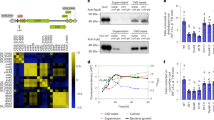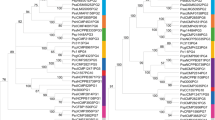Abstract
Type three secretion systems (T3SSs) mediate cell-to-cell interactions between Gram-negative bacteria and eukaryotes. We hypothesized that fluorescent pseudomonads harboring T3SS (T3SS+) would be beneficial to arbuscular mycorrhizal symbiosis because non-pathogenic fluorescent pseudomonads have been previously shown to be much more abundant in mycorrhizal than in non-mycorrhizal roots. We tested this hypothesis by comparing mycorrhization and the associated rhizosphere microbial communities of Medicago truncatula grown in a non-sterile soil inoculated with either the T3SS+ mycorrhiza helper bacterium Pseudomonas fluorescens (C7R12) or a T3SS− mutant of the strain. Results showed that the bacterial secretion system was responsible for the promotion of mycorrhization because root colonization by arbuscular mycorrhizal fungi was not promoted by the T3SS− mutant. The observed T3SS-mediated promotion of mycorrhization was associated with changes in the rhizosphere bacterial communities and the increased occurrence of Claroidoglomeraceae within the intraradical arbuscular mycorrhizal fungi. Furthermore, both pseudomonad strains promoted the host-free growth of a model arbuscular mycorrhizal fungus in vitro, suggesting that T3SS-mediated promotion of mycorrhization occurs during plant-fungal interactions rather than during the pre-symbiotic phase of fungal growth. Taken together, these data provide evidence for the involvement of T3SS in promoting arbuscular mycorrhization by a model fluorescent pseudomonad and suggest the implication of interactions between the bacterium and mycorrhizas.



Similar content being viewed by others
References
Anderson MJ (2001) A new method for non-parametric multivariate analysis of variance. Austral Ecol 26:32–46
Arriagada C, Manquel D, Cornejo P, Soto J, Sampedro I, Ocampo J (2012) Effects of the co-inoculation with saprobe and mycorrhizal fungi on Vaccinium corymbosum growth and some soil enzymatic activities. J Soil Sci Plant Nutr 12(2):283–294
Bailly X, Olivieri I, de Mita S, Cleyet-Marel JC, Béna G (2006) Recombination and selection shape the molecular diversity pattern of nitrogen-fixing Sinorhizobium sp. associated to Medicago. Mol Ecol 15:2719–2734
Bianciotto V, Lumini E, Bonfante P, Vandamme P (2003) ‘Candidatus glomeribacter gigasporarum’ gen. nov., sp. nov., an endosymbiont of arbuscular mycorrhizal fungi. Int J Syst Evol Microbiol 53:121–124
Bonfante P, Anca IA (2009) Plants, mycorrhizal fungi, and bacteria: a network of interactions. Ann Rev Microbiol 63:363–383
Brundrett MC (2009) Mycorrhizal associations and other means of nutrition of vascular plants: understanding the global diversity of host plants by resolving conflicting information and developing reliable means of diagnosis. Plant Soil 320:37–77
Chaparro JM, Badri DV, Vivanco JM (2014) Rhizosphere microbiome assemblage is affected by plant development. ISME J 8:790–803
Cusano AM, Burlinson P, Deveau A, Vion P, Uroz S, Preston GM, Frey-Klett P (2011) Pseudomonas fluorescens BBc6R8 type III secretion mutants no longer promote ectomycorrhizal symbiosis. Environ Microbiol Rep 3:203–210
Dennis JJ, Zylstra GJ (1998) Plasposons: modular self-cloning minitransposon derivatives for rapid genetic analysis of Gram-negative bacterial genomes. Appl Environ Microbiol 64:2710–2715
Eparvier A, Lemanceau P, Alabouvette C (1991) Population dynamics of non-pathogenic Fusarium and fluorescent Pseudomonas strains in rockwool, a substratum for soilless culture. FEMS Microbiol Ecol 86:177–184
Frey-Klett P, Garbaye J, Tarkka M (2007) The mycorrhiza helper bacteria revisited. New Phytopathol 176:22–36
Galán JE, Lara-Tejero M, Marlovits TC, Wagner S (2014) Bacterial type III secretion systems: specialized nanomachines for protein delivery into target cells. Ann Rev Microbiol 68:415–438
Garbaye J (1994) Mycorrhiza helper bacteria: a new dimension to the mycorrhizal symbiosis. New Phytol 128:197–210
Gardes M, Bruns TD (1993) ITS primers with enhanced specificity for basidiomycetes: application to the identification of mycorrhiza and rusts. Mol Ecol 2:113–118
Gollotte A, van Tuinen D, Atkinson D (2004) Diversity of arbuscular mycorrhizal fungi colonising roots of the grass species Agrostis capillaris and Lolium perenne in a field experiment. Mycorrhiza 14:111–117
Gubry-Rangin C, Béna G, Cleyet-Marel JC, Brunel B (2013) Definition and evolution of a new symbiovar, sv. rigiduloides, efficiently nodulating Medicago species. Syst Appl Microbiol 36:490–496
Jones DL, Hodge A, Kuzyakov Y (2004) Plant and mycorrhizal regulation of rhizodeposition. New Phytol 163:459–480
Katzen F, Becker A, Ielmini V, Oddo CG, Ielpi L (1999) New mobilizable vectors suitable for gene replacement in Gram-negative bacteria and their use in mapping of the 3′ end of Xanthomonas campestris pv. Campestris gum operon. Appl Environ Microbiol 65:278–282
Kimura M (1980) A simple model for estimating evolutionary rates of base substitutions through comparative studies of nucleotide sequences. J Mol Evol 16:111–120
King EO, Ward MK, Raney DE (1954) Two simple media for demonstration of pyocyanin and fluorescein. J Lab Clin Med 44:301–307
Lackner G, Moebius N, Hertweck C (2010) Endofungal bacterium controls its host by an hrp type III secretion system. ISME J 5:252–261
Lemanceau P, Alabouvette C (1991) Biological control of fusarium diseases by fluorescent Pseudomonas and non-pathogenic Fusarium. Crop Protect 10:279–286
Macho AP (2016) Subversion of plant cellular functions by bacterial type-III effectors: beyond suppression of immunity. New Phytol 210:51–57
Mazurier S, Lemunier M, Siblot S, Mougel C, Lemanceau P (2004) Distribution and diversity of type III secretion system-like genes in saprophytic and phytopathogenic fluorescent pseudomonads. FEMS Micobiol Ecol 49:455–467
Mirleau P, Delorme S, Philippot L, Meyer J-M, Mazurier S, Lemanceau P (2000) Fitness in soil and rhizosphere of Pseudomonas fluorescens C7R12 compared with a C7R12 mutant affected in pyoverdine synthesis and uptake. FEMS Microbiol Ecol 34:35–44
Mondy S, Lenglet A, Beury-Cirou A, Libanga C, Ratet P, Faure D, Dessaux Y (2014) An increasing opine carbon bias in artificial exudation systems and genetically modified plant rhizospheres leads to an increasing reshaping of bacterial populations. Mol Ecol 23:4846–4861
Moora M, Berger S, Davison J, Öpik M, Bommarco R, Bruelheide H, Kühn I, Kunin WE, Metsis M, Rortais A, Vanatoa A, Vanatoa E, Stout JC, Truusa M, Westphal C, Zobel M, Walther G-R (2011) Alien plants associate with widespread generalist arbuscular mycorrhizal fungal taxa: evidence from a continental-scale study using massively parallel 454 sequencing. J Biogeogr 38(7):1305–1317
Mougel C, Offre P, Ranjard L, Corberand T, Gamalero E, Robin C, Lemanceau P (2006) Dynamic of the genetic structure of bacterial and fungal communities at different developmental stages of Medicago truncatula Gaertn. cv. Jemalong line J5. New Phytol 170:165–175
Naumann M, Schüßler A, Bonfante P (2010) The obligate endobacteria of arbuscular mycorrhizal fungi are ancient heritable components related to the Mollicutes. ISME J 4:862–871
Nelson MS, Sadowski MJ (2015) Secretion systems and signal exchange between nitrogen-fixing rhizobia and legumes. Front Plant Sci 6:491
Normand P, Ponsonnet C, Nesme X, Neyra M, Simonet P (1996) ITS analysis of prokaryotes. In: DL A, van Elsas JD, de Bruijn EI (eds) Molecular microbial ecology manual. Kluwer Academic, Amsterdam, the Netherlands, pp. 1–12
Nuccio EE, Hodge A, Pett-Ridge J, Herman DJ, Weber PK, Firestone MK (2013) An arbuscular mycorrhizal fungus significantly modifies the soil bacterial community and nitrogen cycling during litter decomposition. Environ Microbiol 15:1870–1881
Offre P, Pivato B, Siblot S, Gamalero E, Corberand T, Lemanceau P, Mougel C (2007) Identification of bacterial groups preferentially associated with mycorrhized roots of Medicago truncatula. Appl Environ Microbiol 73:913–921
Offre P, Pivato B, Mazurier S, Siblot S, Berta G, Lemanceau P, Mougel C (2008) Microdiversity of Burkholderiales associated with mycorrhizal and non-mycorrhizal roots of Medicago truncatula. FEMS Microbiol Ecol 65:180–192
Oksanen J, Blanchett FG, Kindt R, Legendre P, Minchin PR, O’Hara RB, Simpson GL, Solymos P, Stevens MHM, Wagner H (2012) Vegan: community ecology package. R Package 2.0.3 Downloaded from http://CRAN.R-project.org/package=vegan
Oliveira RP, Castro PML, Dodd JC, Vosatka M (2006) Different native arbuscular mycorrhizal fungi influence the coexistence of two plant species in a highly alkaline anthropogenic sediment. Plant Soil 287:209–221
Pivato B, Mazurier S, Lemanceau P, Siblot S, Berta G, Mougel C, van Tuinen D (2007) Medicago species affect the community composition of arbuscular mycorrhizal fungi associated with roots. New Phytol 176:197–210
Pivato B, Offre P, Marchelli S, Barbonaglia B, Mougel C, Lemanceau P, Berta G (2009) Bacterial effects on arbuscular mycorrhizal fungi and mycorrhization as influenced by the bacteria, fungi and host-plant. Mycorrhiza 19:81–90
Rangin C, Brunel B, Cleyet-Marel JC, Perrineau MM, Béna G (2008) Effects of Medicago truncatula genetic diversity, rhizobial competition and strain effectiveness on the diversity of a natural Sinorhizobium spp. community. Appl Environ Microbiol 74:5653–5661
Ranjard L, Lejon PHD, Mougel C, Scherer L, Merdinoglu D, Chaussod R (2003) Sampling strategy in molecular microbial ecology: influence of soil sample size on DNA fingerprinting analysis of fungal and bacterial communities. Environ Microbiol 5:1111–1120
Redecker D, Kodner R, Graham LE (2000) Glomalean fungi from the Ordovician. Science 289:1920–1921
Rezzonico F, Binder C, Défago G, Moënne-Loccoz Y (2005) The type III secretion system of biocontrol Pseudomonas fluorescens KD targets the phytopathogenic chromista Pythium ultimum and promotes cucumber protection. MPMI 18:991–1001
Saitou N, Nei M (1987) The neighbor-joining method: a new method for reconstructing phylogenetic trees. Mol Biol Evol 4:406–425
Sambrook J, Russel DW (2001) Molecular cloning: a laboratory manual, 3rd edn. Cold Spring Harbor Laboratory Press, New York
Sanchez L, Weidmann S, Arnould C, Bernard AR, Gianinazzi S, Gianinazzi-Pearson V (2005) Pseudomonas fluorescens and Glomus mosseae trigger DMI3-dependent activation of genes related to a signal transduction pathway in roots of Medicago truncatula. Plant Physiol 139:1065–1077
Scheublin TR, Sanders IR, Keel C, Van Der Meer JR (2010) Characterisation of microbial communities colonizing the hyphal surfaces of arbuscular mycorrhizal fungi. ISME J 4:752–763
Sequerra J, Marmeisse R, Valla G, Normand P, Capellano A, Moiroud A (1997) Taxonomic position and intraspecific variability of the nodule forming Penicillium nodositatum inferred from RFLP analysis of the ribosomal intergenic spacer and random amplified polymorphic DNA. Mycol Res 101:465–472
Singh BK, Nunan N, Ridgway KP, McNicol J, Young JPY, Daniell TJ, Prosser J, Millar P (2008) Relationship between assemblages of mycorrhizal fungi and bacteria on grass roots. Environ Microbiol 10:534–541
Smith SE, Read DJ (2008) Mycorrhizal symbiosis, 3rd edn. Academic Press, Amsterdam
Torres-Cortés G, Ghignone S, Bonfante P, Schüßler A (2015) Mosaic genome of endobacteria in arbuscular mycorrhizal fungi: transkingdom gene transfer in an ancient mycoplasma-fungus association. Proc Natl Acad Sci U S A 112:7785–7790
Trouvelot A, Kough JL, Gianinazzi-Pearson V (1986) Mesure du taux de mycorhization VA d’un système radiculaire. Recherche de méthodes d’estimation ayant une signification fonctionnelle. In: Gianinazzi-Pearson V, Gianinazzi S (eds) Physiological and genetical aspects of mycorrhizae. INRA Presse, Paris, France, pp. 217–221
Van Tuinen D, Jacquot E, Zhao B, Gollotte A, Gianinazzi-Pearson V (1998) Characterization of root colonization profiles by a microcosm community of arbuscular mycorrhizal fungi using 25S rDNA-targeted nested PCR. Mol Ecol 7:879–887
Vestergard M, Henry F, Rangel-Castro JI, Michelsen A, Prosser JI, Christensen S (2008) Rhizosphere bacterial community composition responds to arbuscular mycorrhiza, but not to reductions in microbial activity induced by foliar cutting. FEMS Microbiol Ecol 64:78–89
Viollet A, Corberand T, Mougel C, Robin A, Lemanceau P, Mazurier S (2011) Fluorescent pseudomonads harboring type III secretion genes are enriched in the mycorrhizosphere of Medicago truncatula. FEMS Micobiol Ecol 75:457–467
Warmink JA, van Elsas JD (2008) Selection of bacterial populations in the mycosphere of Laccaria proxima: is type III secretion involved? ISME J 2:887–900
Acknowledgments
This work was funded by the Regional Council of Burgundy, RCB (Dijon, France), and supported by a doctoral grant to A. Viollet by “Conseil Régional de Bourgogne” and INRA (EA, SPE). The authors are grateful to Thérèse Corberand, Catherine Barraud, and Jerôme Manufacier for technical assistance and to Diana Warwick for correcting the English text.
Author information
Authors and Affiliations
Corresponding author
Rights and permissions
About this article
Cite this article
Viollet, A., Pivato, B., Mougel, C. et al. Pseudomonas fluorescens C7R12 type III secretion system impacts mycorrhization of Medicago truncatula and associated microbial communities. Mycorrhiza 27, 23–33 (2017). https://doi.org/10.1007/s00572-016-0730-3
Received:
Accepted:
Published:
Issue Date:
DOI: https://doi.org/10.1007/s00572-016-0730-3




